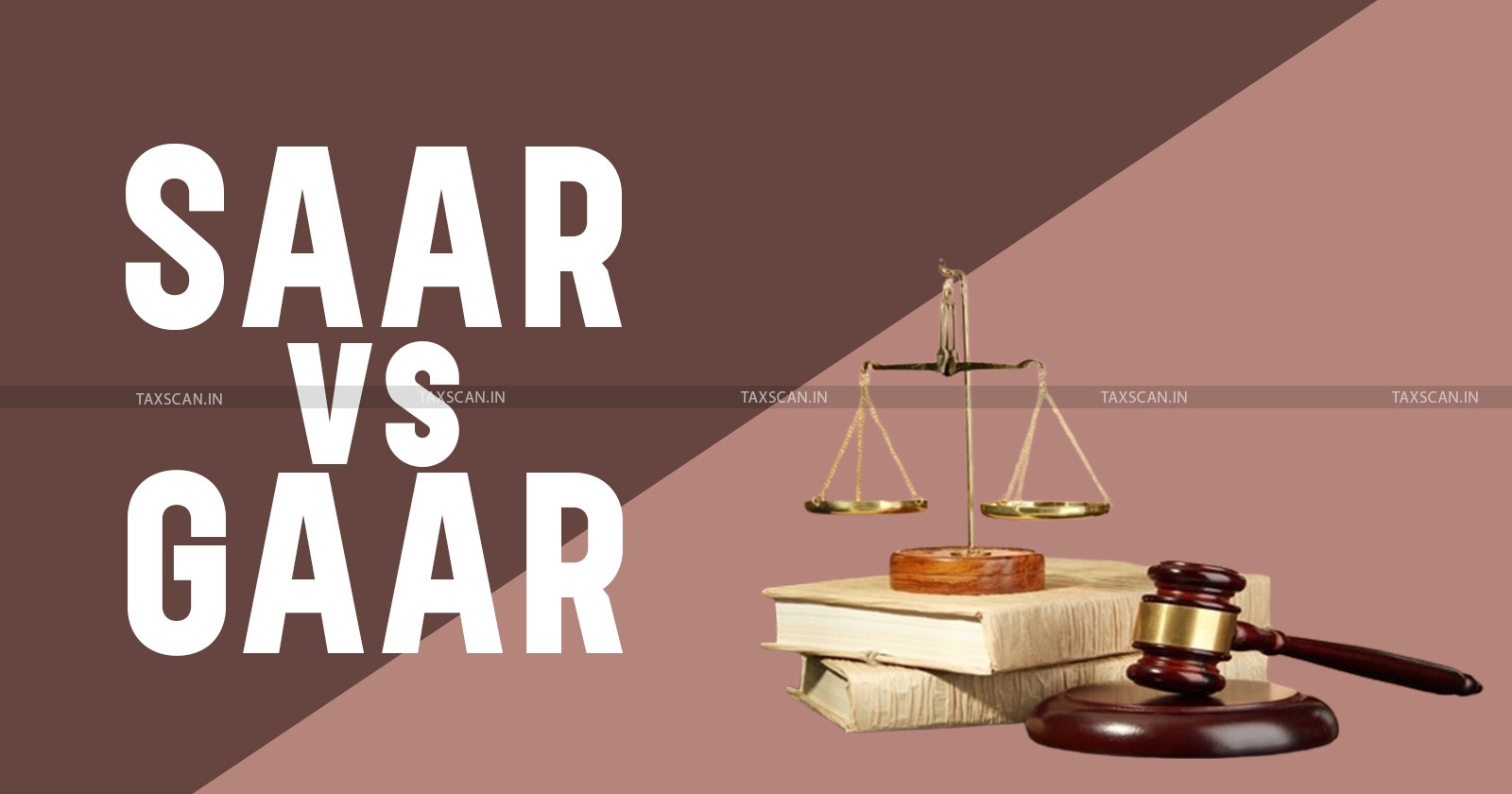[TAXSCAN 360] SAAR vs GAAR in Tax Laws: Do they Clash or Intersect?
An analysis of how Specific Anti-Avoidance Rules (SAAR) and General Anti-Avoidance Rules (GAAR) function and interact within India's tax system

GAAR – SAAR – SAAR in tax law – GAAR in tax law – SAAR vs GAAR – General Anti Avoidance Rules – Specific Anti Avoidance Rules – Taxscan
GAAR – SAAR – SAAR in tax law – GAAR in tax law – SAAR vs GAAR – General Anti Avoidance Rules – Specific Anti Avoidance Rules – Taxscan
Introduction
In India ,the General Anti-Avoidance Rules ( GAAR ) and Specific Anti-Avoidance Rules ( SAAR ) are the two main instruments wielded to combat tax avoidance. These measures are necessary to make sure that taxpayers don't take unfair advantage of legal breaks to lower their tax obligations, which will be antithetical to the spirit of law. In this article, we'll explore the scope of both SAAR and GAAR, as well as examine if they work in tandem or not.
SAAR and GAAR: What Do They Mean?
- SAAR or Specific Anti-Avoidance Rule
The acronym SAAR refers to Specific Anti-Avoidance Rule. It is employed with the intention to address particular tax avoidance methods. Their purpose is to stop taxpayers from lowering their tax bill by taking advantage of tax law loopholes.
Tax avoidance, albeit being legal, is practice that acts against the spirit of law. It encompasses legal strategies employed to minimize tax liabilities within the framework of tax laws.
Read More: Tax Evasion v. Tax Avoidance: Know the Difference as an Income Earner
SAARs target specific agreements or transactions that are suspected of being possible channels for tax evasion or avoidance. Controlled foreign corporations, thin capitalization, and transfer pricing regulations are a few examples of this. Their implementation vary from jurisdiction to jurisdiction.
Mechanism : In practice, SAAR empowers tax authorities to scrutinize transactions suspected of falling within its specific purview. When a potential SAAR case is identified, tax officials assess whether the transaction meets the criteria outlined in the law. If deemed applicable, the transaction may be subject to additional scrutiny or penalties to prevent tax avoidance.
Example: A more direct example of SAAR is found in Section 94 of the Income-tax Act, 1961. The section deals with things like dividend stripping and bond stripping. Another example is Section 2(22)(e) which forbids closely held corporate shareholders from taking advantage of their gains without paying dividend tax.
Applicability : As the name suggests, these rules are specific to certain situations and only applicable to them. The issue here is that businessmen will eventually circumvent these “specific situations” and find ways to avoid taxes legally but unethically. To curb that, the law was necessitated to be more broader and general in application. Thus, GAAR was born.
- GAAR or General Anti Avoidance Rules.
Introduced in India on April 1, 2017, GAAR's adoption followed its proposal in the Direct Taxes Code Bill of 2009, prompted by landmark cases such as the Vodafone-Hutchison Essar deal in the Cayman Islands. They're effective from the financial year of 2018 to 2019.
GAAR refers to General Anti Avoidance Rules, a regulatory framework established by the Income Tax Act with the aim of reducing aggressive tax evasion/avoidance tactics. It serves as an antidote against the practice of people or businesses using legal loopholes to avoid paying their fair share of taxes. It differs from SAAR as it's applicability is broader and not particular to a situation.
The provisions for GAAR are given in Chapter X-A of the Income Tax Act, 1961. The application of GAAR and the conditions under which it shouldn't be applied are enumerated in the Income Tax Rules, 1962.
Mechanism : GAAR empowers tax authorities to scrutinize potentially abusive tax arrangements. Upon identifying a case, the Assessing Officer refers it to the Tax Commissioner, who assesses whether it qualifies as an Impermissible Avoidance Arrangement ( IAA ).
According to Section 144BA of the IT Act, a tax officer can issue a notice to a taxpayer if he has data on record to prove that any arrangement entered into by the taxpayer is an IAA and the GAAR provisions must be triggered.
A tax arrangement is “impermissible” if
- It creates rights or obligations ( not ordinarily implemented ) between persons dealing at arm’s length
Example: Splitting your income between family members to lower tax burden.
- It results directly or indirectly in misuse or abuse of the Income Tax Act provisions
- It lacks commercial substance or is deficient in commercial substance.
- It is carried out in a manner not ordinarily employed for bona fide purpose
If the arrangement is deemed as IAA, the matter may proceed to an approving Panel for a final determination. The panel may at its discretion take action in accordance to the situation.
Applicability: The main objective behind GAAR is that when a transaction is made it must be genuine, and not simply for availing a tax cut. Here, the mere fact that the transaction is lawful does not imply that it is acceptable. Therefore GAAR will be drawn in situations where the only company goal is to receive a tax benefit, as tax benefit provisions are for encouraging tax compliance, not to bypass obligations.
SAAR or GAAR: Who has the Upperhand?
Both SAAR and GAAR deal with tax avoidance, thus there is undoubtedly an overlap between the two ideas.
Since the common principle is that "specific prevails over general," it may be understood that transactions that have attracted SAAR would not be evaluated under GAAR.
But there's a catch. What if the situation attracts SAAR but is also consistent with the requirements that attract GAAR? In such a situation, do the provisions of SAAR under Chapter X clash or Intersect with the impermissible avoidance arrangements under GAAR in Chapter X-A ?
Recently, Telangana High Court in a case examined whether a transaction that falls under the provisions of GAAR can also attract SAAR if the conditions are met. That is, the court examined whether SAAR and GAAR can be applied independently or together.
In this case, The Court observed that SAAR under Chapter X of the Act, which the taxpayer relied on, existed before the GAAR provisions were inserted under Chapter X-A. Historically, courts, including the Supreme Court of India, have held that when a special provision of law is enacted, general provisions of the Act cannot be invoked. However, this principle cannot be applied here, as GAAR was enacted after the specific provisions. Notably, Chapter X-A of the Act begins with a non-obstante clause, giving it an overriding effect over all other provisions of the Act.
The non-obstante clause, which states that the requirements of GAAR apply notwithstanding anything in the IT Act, opens Section 95(1) of the Act. Consequently, it is understood that the provisions of Chapter X-A supersede all other sections of the Act.
Furthermore, section 100 of the IT Act states that Chapter X-A is applicable in addition to or as a substitute for any other method for assessing tax liability.
By Virtue of the rules under section 95 and 100 of the Act, Chapter X-A may be used in tandem with or as an alternative for other parts of the Income Tax Act.
It is made clear that in situations where SAAR or GAAR has to be chosen over one another, GAAR will prevail over SAAR. It is also given that SAAR and GAAR can in fact, work in cooperation if necessary. Therefore, it is understood that SAAR and GAAR don't clash, but rather intersect and work in tandem.
How SAAR and GAAR work together
If implemented properly, the dual wielding of SAAR and GAAR can effectively reduce tax avoidance tendencies in the country. The following are some of the pros of combining and applying both mechanisms:
- The clarity under SAAR offer certainty, while GAAR’s broad principles provide the flexibility needed to tackle unforeseen avoidance schemes.
- The combination of SAAR and GAAR will deter taxpayers from engaging in tax avoidance, knowing that both specific and general rules are in place and that they can be applied jointly or independently
- Clear, specific rules ensure compliance with known tactics, while broad principles adapt to new avoidance schemes. Thus, both mechanisms provide a robust framework capable of evolving and adapting to upcoming hurdles in respect to tax avoidance.
- The dual approach reduces litigation by minimizing loopholes and ambiguities.
International Perspectives
A number of nations, including Australia, the Netherlands, Canada, New Zealand, China, Poland, the United Kingdom, the United States, France, and Germany, have passed laws implementing GAAR. Some of the historic codification of anti-avoidance rules are given below.
- In 1919, the German Tax Ordinance codified a comprehensive general anti-avoidance rule which was then successfully adopted and implemented by France in 1941, Argentina in 1946, Spain in 1963 and Italy in 1990.
- In 2010, the doctrine of economic substance was introduced into the “Internal Revenue Code” by the USA, essentially codifying anti avoidance rules.
- In 2013, the United Kingdom implemented a general anti-abuse regulation known as the "2013 Finance Act." This law, which targets abusive tax planning, went into effect in 2017.
Relevant Cases
- Vodafone International Holdings BV v. Union of India (2012):This landmark case highlighted the need for GAAR, leading to its introduction. The Supreme Court ruled in favor of Vodafone in the tax avoidance case, emphasizing the limitations of existing anti-avoidance rules. This in turn prompted the introduction of GAAR inorder to curb similar tax avoidance tactics.
- E Trade Mauritius Ltd. vs. ADIT (2010):This case dealt with the application of SAAR in preventing tax avoidance through treaty shopping.
- McDowell & Co. Ltd. v. CTO (1985): This case established the principle that tax planning should be legitimate and not a colorable device, setting a precedent for GAAR principles.
- Oxford Ayyappa Consulting Services India Private Limited vs Rubaina Khatoon: In this case the Telengana High Court held that GAAR has an overriding effect on SAAR.
Conclusion
SAAR and GAAR are essential within the Indian tax law framework since they deal with tax avoidance by establishing both general and specialized regulations. While GAAR gives a malleable mechanism to tackle intricate and unanticipated methods, SAAR offers precise recommendations for known avoidance strategies. The difference between these methods makes tax laws efficient by providing a strong, flexible foundation that can address the evolving issues regarding tax avoidance and evasion.
Support our journalism by subscribing to Taxscan premium. Follow us on Telegram for quick updates


